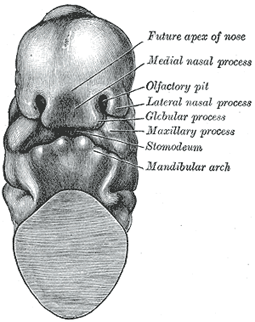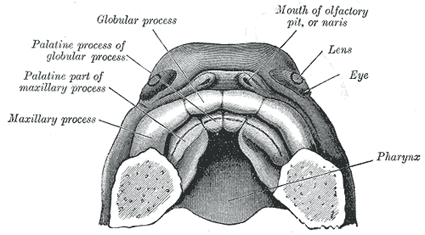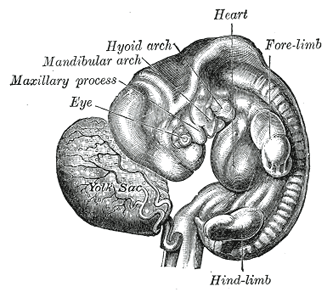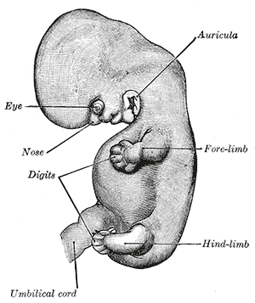 |
| FIG. 42– Floor of pharynx of embryo shown in Fig. 40. |
|
| |
| The Branchial or Visceral Arches and Pharyngeal Pouches.—In the lateral walls of the anterior part of the fore-gut five pharyngeal pouches appear (Fig. 42); each of the upper four pouches is prolonged into a dorsal and a ventral diverticulum. Over these pouches corresponding indentations of the ectoderm occur, forming what are known as the branchial or outer pharyngeal grooves. The intervening mesoderm is pressed aside and the ectoderm comes for a time into contact with the entodermal lining of the fore-gut, and the two layers unite along the floors of the grooves to form thin closing membranes between the fore-gut and the exterior. Later the mesoderm again penetrates between the entoderm and the ectoderm. In gill-bearing animals the closing membranes disappear, and the grooves become complete clefts, the gill-clefts, opening from the pharynx on to the exterior; perforation, however, does not occur in birds or mammals. The grooves separate a series of rounded bars or arches, the branchial or visceral arches, in which thickening of the mesoderm takes place (Figs. 40 and 41). The dorsal ends of these arches are attached to the sides of the head, while the ventral extremities ultimately meet in the middle line of the neck. In all, six arches make their appearance, but of these only the first four are visible externally. The first arch is named the mandibular, and the second the hyoid; the others have no distinctive names. In each arch a cartilaginous bar, consisting of right and left halves, is developed, and with each of these there is one of the primitive aortic arches. |
| |
| The mandibular arch lies between the first branchial groove and the stomodeum; from it are developed the lower lip, the mandible, the muscles of mastication, and the anterior part of the tongue. Its cartilaginous bar is formed by what are known as Meckel’s cartilages (right and left) (Fig. 43); above this the incus is developed. The dorsal end of each cartilage is connected with the ear-capsule and is ossified to form the malleus; the ventral ends meet each other in the region of the symphysis menti, and are usually regarded as undergoing ossification to form that portion of the mandible which contains the incisor teeth. The intervening part of the cartilage disappears; the portion immediately adjacent to the malleus is replaced by fibrous membrane, which constitutes the spheno-mandibular ligament, while from the connective tissue covering the remainder of the cartilage the greater part of the mandible is ossified. From the dorsal ends of the mandibular arch a triangular process, the maxillary process, grows forward on either side and forms the cheek and lateral part of the upper lip. The second or hyoid arch assists in forming the side and front of the neck. From its cartilage are developed the styloid process, stylohyoid ligament, and lesser cornu of the hyoid bone. The stages probably arises in the upper part of this arch. The cartilage of the third arch gives origin to the greater cornu of the hyoid bone. The ventral ends of the second and third arches unite with those of the opposite side, and form a transverse band, from which the body of the hyoid bone and the posterior part of the tongue are developed. The ventral portions of the cartilages of the fourth and fifth arches unite to form the thyroid cartilage; from the cartilages of the sixth arch the cricoid and arytenoid cartilages and the cartilages of the trachea are developed. The mandibular and hyoid arches grow more rapidly than those behind them, with the result that the latter become, to a certain extent, telescoped within the former, and a deep depression, the sinus cervicalis, is formed on either side of the neck. This sinus is bounded in front by the hyoid arch, and behind by the thoracic wall; it is ultimately obliterated by the fusion of its walls. |
 |
| FIG. 43– Head and neck of a human embryo eighteen weeks old, with Meckel’s cartilage and hyoid bar exposed. (After Kölliker.) |
| |
 |
| FIG. 44– Under surface of the head of a human embryo about twenty-nine days old. (After His.) |
| |
| From the first branchial groove the concha auriculæ and external acoustic meatus are developed, while around the groove there appear, on the mandibular and hyoid arches, a number of swellings from which the auricula or pinna is formed. The first pharyngeal pouch is prolonged dorsally to form the auditory tube and the tympanic cavity; the closing membrane between the mandibular and hyoid arches is invaded by mesoderm, and forms the tympanic membrane. No traces of the second, third, and fourth branchial grooves persist. The inner part of the second pharyngeal pouch is named the sinus tonsillaris; in it the tonsil is developed, above which a trace of the sinus persists as the supratonsillar fossa. The fossa of Rosenmüller or lateral recess of the pharynx is by some regarded as a persistent part of the second pharyngeal pouch, but it is probably developed as a secondary formation. From the third pharyngeal pouch the thymus arises as an entodermal diverticulum on either side, and from the fourth pouches small diverticula project and become incorporated with the thymus, but in man these diverticula probably never form true thymus tissue. The parathyroids also arise as diverticula from the third and fourth pouches. From the fifth pouches the ultimobranchial bodies originate and are enveloped by the lateral prolongations of the median thyroid rudiment; they do not, however, form true thyroid tissue, nor are any traces of them found in the human adult. |
| |
| The Nose and Face.—During the third week two areas of thickened ectoderm, the olfactory areas, appear immediately under the fore-brain in the anterior wall of the stomodeum, one on either side of a region termed the fronto-nasal process (Fig. 44). By the upgrowth of the surrounding parts these areas are converted into pits, the olfactory pits, which indent the fronto-nasal process and divide it into a medial and two lateral nasal processes (Fig. 45). The rounded lateral angles of the medial process constitute the globular processes of His. The olfactory pits form the rudiments of the nasal cavities, and from their ectodermal lining the epithelium of the nasal cavities, with the exception of that of the inferior meatuses, is derived. The globular processes are prolonged backward as plates, termed the nasal laminæ: these laminæ are at first some distance apart, but, gradually approaching, they ultimately fuse and form the nasal septum; the processes themselves meet in the middle line, and form the premaxillæ and the philtrum or central part of the upper lip (Fig. 48). The depressed part of the medial nasal process between the globular processes forms the lower part of the nasal septum or columella; while above this is seen a prominent angle, which becomes the future apex (Figs. 45, 46), and still higher a flat area, the future bridge, of the nose. The lateral nasal processes form the alæ of the nose. |
 |
| FIG. 45– Head end of human embryo of about thirty to thirty-one days. (From model by Peters.) |
| |
 |
| FIG. 46– Same embryo as shown in Fig. 45, with front wall of pharynx removed. |
| |
 |
| FIG. 47– Head of a human embryo of about eight weeks, in which the nose and mouth are formed. (His.) |
| |
 |
| FIG. 48– Diagram showing the regions of the adult face and neck related to the fronto-nasal process and the branchial arches. |
| |
 |
| FIG. 49– Primitive palate of a human embryo of thirty-seven to thirty-eight days. (From model by Peters.) On the left side the lateral wall of the nasal cavity has been removed. |
| |
 |
| FIG. 50– The roof of the mouth of a human embryo, aged about two and a half months, showing the mode of formation of the palate. (His.) |
| |
| Continuous with the dorsal end of the mandibular arch, and growing forward from its cephalic border, is a triangular process, the maxillary process, the ventral extremity of which is separated from the mandibular arch by a > shaped notch (Fig. 44). The maxillary process forms the lateral wall and floor of the orbit, and in it are ossified the zygomatic bone and the greater part of the maxilla; it meets with the lateral nasal process, from which, however, it is separated for a time by a groove, the naso-optic furrow, that extends from the furrow encircling the eyeball to the olfactory pit. The maxillary processes ultimately fuse with the lateral nasal and globular processes, and form the lateral parts of the upper lip and the posterior boundaries of the nares (Figs. 47, 48). From the third to the fifth month the nares are filled by masses of epithelium, on the breaking down and disappearance of which the permanent openings are produced. The maxillary process also gives rise to the lower portion of the lateral wall of the nasal cavity. The roof of the nose and the remaining parts of the lateral wall, viz., the ethmoidal labyrinth, the inferior nasal concha, the lateral cartilage, and the lateral crus of the alar cartilage, are developed in the lateral nasal process. By the fusion of the maxillary and nasal processes in the roof of the stomodeum the primitive palate (Fig. 49) is formed, and the olfactory pits extend backward above it. The posterior end of each pit is closed by an epithelial membrane, the bucco-nasal membrane, formed by the apposition of the nasal and stomodeal epithelium. By the rupture of these membranes the primitive choanæ or openings between the olfactory pits and the stomodeum are established. The floor of the nasal cavity is completed by the development of a pair of shelf-like palatine processes which extend medial-ward from the maxillary processes (Figs. 50 and 51); these coalesce with each other in the middle line, and constitute the entire palate, except a small part in front which is formed by the premaxillary bones. Two apertures persist for a time between the palatine processes and the premaxillæ and represent the permanent channels which in the lower animals connect the nose and mouth. The union of the parts which form the palate commences in front, the premaxillary and palatine processes joining in the eighth week, while the region of the future hard palate is completed by the ninth, and that of the soft palate by the eleventh week. By the completion of the palate the permanent choanæ are formed and are situated a considerable distance behind the primitive choanæ. The deformity known as cleft palate results from a non-union of the palatine processes, and that of harelip through a non-union of the maxillary and globular processes (see page 199). The nasal cavity becomes divided by a vertical septum, which extends downward and backward from the medial nasal process and nasal laminæ, and unites below with the palatine processes. Into this septum a plate of cartilage extends from the under aspect of the ethmoid plate of the chodrocranium. The anterior part of this cartilaginous plate persists as the septal cartilage of the nose and the medial crus of the alar cartilage, but the posterior and upper parts are replaced by the vomer and perpendicular plate of the ethmoid. On either side of the nasal septum, at its lower and anterior part, the ectoderm is invaginated to form a blind pouch or diverticulum, which extends backward and upward into the nasal septum and is supported by a curved plate of cartilage. These pouches form the rudiments of the vomero-nasal organs of Jacobson, which open below, close to the junction of the premaxillary and maxillary bones. |
 |
| FIG. 51– Frontal section of nasal cavities of a human embryo 28 mm. long. (Kollmann.) |
| |
| |
| The Limbs.—The limbs begin to make their appearance in the third week as small elevations or buds at the side of the trunk (Fig. 52). Prolongations from the muscle- and cutis-plates of several primitive segments extend into each bud, and carry with them the anterior divisions of the corresponding spinal nerves. The nerves supplying the limbs indicate the number of primitive segments which contribute to their formation—the upper limb being derived from seven, viz., fourth cervical to second thoracic inclusive, and the lower limb from ten, viz., twelfth thoracic to fourth sacral inclusive. The axial part of the mesoderm of the limb-bud becomes condensed and converted into its cartilaginous skeleton, and by the ossification of this the bones of the limbs are formed. By the sixth week the three chief divisions of the limbs are marked off by furrows—the upper into arm, forearm, and hand; the lower into thigh, leg, and foot (Fig. 53). The limbs are at first directed backward nearly parallel to the long axis of the trunk, and each presents two surfaces and two borders. Of the surfaces, one—the future flexor surface of the limb—is directed ventrally; the other, the extensor surface, dorsally; one border, the preaxial, looks forward toward the cephalic end of the embryo, and the other, the postaxial, backward toward the caudal end. The lateral epicondyle of the humerus, the radius, and the thumb lie along the preaxial border of the upper limb; and the medial epicondyle of the femur, the tibia, and the great toe along the corresponding border of the lower limb. The preaxial part is derived from the anterior segments, the postaxial from the posterior segments of the limb-bud; and this explains, to a large extent, the innervation of the adult limb, the nerves of the more anterior segments being distributed along the preaxial (radial or tibial), and those of the more posterior along the postaxial (ulnar or fibular) border of the limb. The limbs next undergo a rotation or torsion through an angle of 90° around their long axes the rotation being effected almost entirely at the limb girdles. In the upper limb the rotation is outward and forward; in the lower limb, inward and backward. As a consequence of this rotation the preaxial (radial) border of the fore-limb is directed lateralward, and the preaxial (tibial) border of the hind-limb is directed medialward; thus the flexor surface of the fore-limb is turned forward, and that of the hind-limb backward. |
 |
| FIG. 52– Human embryo from thirty-one to thirty-four days. (His.) |
| |
 |
| FIG. 53– Embryo of about six weeks. (His.) |
| |












